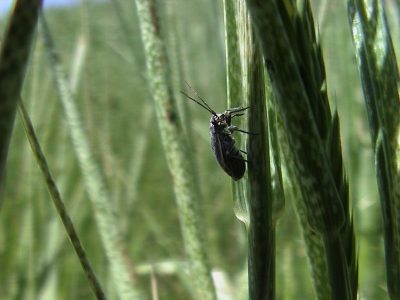For producers concerned about discolored wheatgrass in pastures and fields, the University of Wyoming Extension has released a free digital publication on how to identify and treat black grass bug infestations.
Especially in eastern Wyoming, black grass bugs can cause significant damage to cool season grasses, severely reducing the nutrient content of livestock forage and preventing seed formation.

“This insect species can become a serious pest of wheatgrass pastures that are important either for spring grazing or later harvesting for hay,” says Scott Schell, UW Extension entomologist and co-author of the new publication. “The insects can also move from infested pastures, highway right-of-ways, or Conservation Reserve Program fields into winter wheat fields and damage the crop.”
These small, cold-tolerant insects emerge in early spring and feed on the intermediate and crested wheatgrasses common in eastern Wyoming. The discoloration and poor growth caused by their feeding is easily mistaken for damage caused by drought or frost.
Damaged plants often recover with adequate moisture later in the season, but infestations during a drought may result in lasting damage.
The new publication presents various options for control, including grazing practices, mowing, prescribed burning, and chemical treatment. Depending on when the infestation is detected, or whether the goal is to prevent a future infestation, recommended strategies may vary.
To be effective, insecticide treatments must be completed early in the season, before the insects have matured and deposited eggs, says Schell. Ideally, chemical treatment should take place after the majority of the insects hatch, but before they have caused extensive damage.
Previous studies have shown that if successful control is achieved, it can take several years before the bugs reach damaging population levels again.
The authors also note that control may not be necessary every year. Black grass bug populations fluctuate in response to variation in temperature, moisture, snowpack, and other conditions that affect their life cycle. However, if a wheatgrass pasture deteriorates to a point at which it’s no longer productive, they recommend remediation rather than attempting control.
To view the new publication, visit https://bit.ly/black-grass-bug-wy. Contact Schell at sschell@uwyo.edu or (307) 766-2508 with questions.




